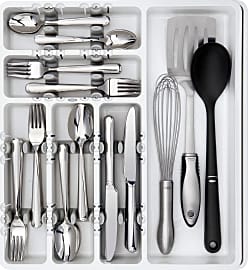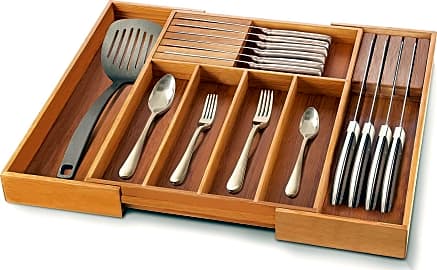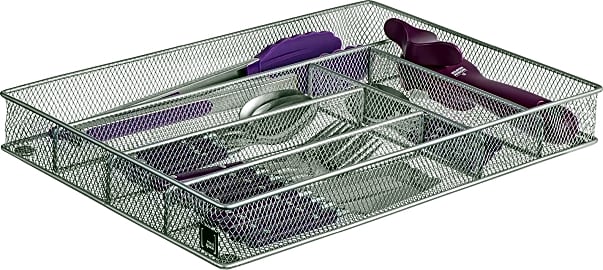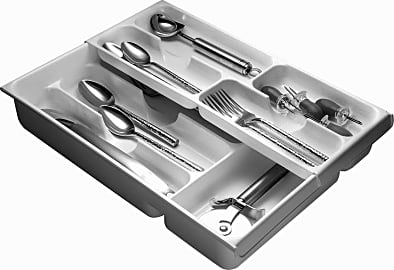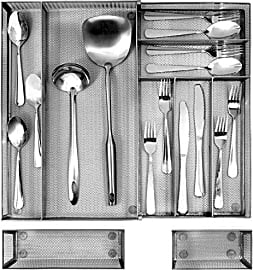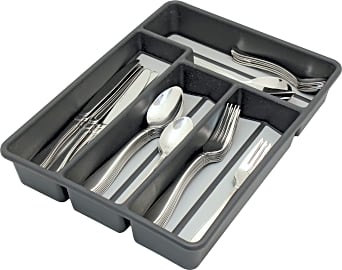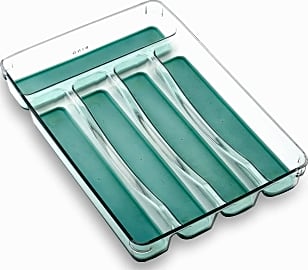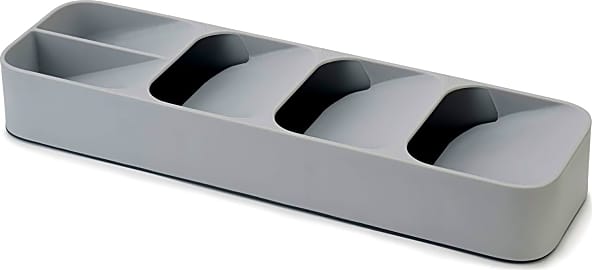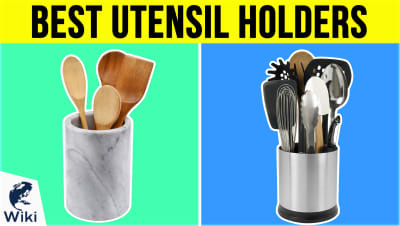The 10 Best Silverware Trays

This wiki has been updated 37 times since it was first published in April of 2016. Tired of rummaging through your kitchen drawers to find the right utensil? Get yourself organized with one of these convenient silverware trays. Available in a variety of designs, sizes, and materials to suit your cutlery arsenal and match just about any decor, these will keep your knives, forks, spoons, pizza cutters, tongs, and other items tidy and handy at all times. When users buy our independently chosen editorial recommendations, we may earn commissions to help fund the Wiki.
Editor's Notes
August 14, 2020:
When updating this list we wanted to maintain its diversity of materials. However, the Masirs Metal became unavailable and we realized that there wasn't much differentiating the Storage Technologies Mesh from the Mindspace Mesh Collection, which has nearly the same dimensions but is offered in multiple sizes and a bit more ruggedly made. So to ensure we had one more dependable metal selection, we brought on the WuGeShop Kitchen. Most expandable designs are plastic or bamboo, and so we felt this would be ideal for those who like that versatility but prefer metal. It comes with two standalone baskets for extra storage, is coated for rust resistance, and can be easily rinsed in the sink when needed.
We also said goodbye to the Rubbermaid Tan, which we felt was a bit overpriced considering its simple design, when the equally straightforward Made Smart Classic offers the same durability with a cleaner look and cheaper price. To fill the gap, we added the Bino Organizer, another aesthetically-pleasing selection made from durable plastic without toxins, BPA, or phthalates. Its nonskid interiors are removable for cleaning and the double-molded design is hardy and not likely to crack unless seriously abused.
Finally, we brought the Joseph Joseph 85119 into the fold today for those who have to make the most of little storage space in studio apartments, campers, RVs, or any diminutive kitchen. Its angled construction can accommodate a pretty generous amount of flatware, enough for a few people at least, and has little stamped icons to help you remember what goes where if you choose to store utensils handles out. Just be sure to measure its height to ensure it will fit in your drawers. And if you have cooking utensils to store, be aware that you'll have to get a separate organizer for those.
July 24, 2019:
This latest update saw the addition of the Mindspace Mesh Collection, Bambusi Divider, and Dial Industries Sliding at the expense of the Mountain Woods Expandable, JA Kitchens Organizer, and Spectrum Diversified Grid. The former two had availability issues and so regrettably had to be removed, while we felt the latter was better suited for use with office supplies or in classrooms.
While many of our selections sport rubber padding and feet, like the Storage Technologies Mesh, Masirs Metal, and Mindspace Mesh Collection, to keep them from sliding around, if you have the room, pairing one with a drawer liner can help ensure it stays put.
We favored stainless steel, strong plastic, and bamboo for our selections, and prioritized sets that make great use of limited space, such as expandable ones (Bambusi Divider, Oxo Good Grips White, Pristine Bamboo Holder) and a tiered option (Dial Industries Sliding) over others. In this vein, we particularly like the Oxo Good Grips White for its special dividers that enable the user to store two separate sets of flatware at one time.
Special Honors
Cliq Studios Two-Tiered Drawer You can double the storage surface of a single drawer with this Two-Tiered selection from Cliq Studios, which boasts a top tray that glides independently on side-mounted steel slides, providing three-quarter access to the tray beneath. It uses soft-close technology, so you'll never have to worry about accidentally slamming and damaging it. cliqstudios.com
WoodenYouLoveThis Under Cabinet Organizer A handmade drawer that attaches to and slides out from beneath upper cabinets, the WoodenYouLoveThis Under Cabinet Organizer is available in myriad widths and wood types, including alder, cherry, maple, oak, and more. This space-saving design sports removable dividers that make it very easy to wipe down, and it only requires four Philips screws to install. It can be shipped with filler blocks for cabinets with recessed or molded bottoms. etsy.com
Williams-Sonoma Marble This flatware organizer from Williams-Sonoma is handcrafted from natural white marble and sports a polished finish, with natural variations in color and pattern that make it truly unique. It features five compartments of varying size and looks excellent with both contemporary and rustic decors. williamssonoma.com
A Brief History of Silverware
Knives have been around since prehistoric times, when they were made from sharpened pieces of flint.
You wouldn't think that silverware would have a very engaging backstory, but the fact is that its history is filled with innovation and controversy. Well, there was really only a few innovations and just the one controversy, but the point stands.
Knives have been around since prehistoric times, when they were made from sharpened pieces of flint. They doubled as weapons, while also being used to rip flesh from fallen prey.
They weren't used at the dinner table, though — or if they were, it was to stab an enemy in the eye. Meat was either gnawed off or sliced up before cooking, and knives had sharp points rather than serrated sides.
Spoons, on the other hand, have virtually always been present at meals. The first spoons were probably just seashells or even cupped hands, but by 1000 B.C.E., models with handles made from animal bone began to crop up in Egypt.
Most spoons at this time were made of wood, although the ones used by the rich and powerful were often made from bronze or silver.
Forks, surprisingly enough, made their debut in China around 2400 B.C.E., which means they actually predate chopsticks. These only had two prongs, however, and were used for serving food rather than eating it, as people continued to prefer to use nature's forks: their fingers.
A fork even caused a scandal in 1004 C.E. when the niece of a Byzantine emperor used a golden fork at her wedding. The guests were all shocked, as this was seen as an affront to God — who, again, had given us fingers — as well as unforgivably depraved. Her death from the plague a few years later was seen as just punishment for her wicked ways.
When the Middle Ages rolled around, utensils were rarely seen at the dinner table, and were often reserved solely for the wealthy. Instead, food was served on slices of bread called "trenchers." You might still see knives occasionally, and sometimes two blades were used to cut meat — one to hold, the other to saw — instead of forks.
In 1669, the French king Louis XIV declared that all knives brought to the dinner table should have blunt ends. This was to prevent stabbings during meals, because apparently ol' Louis hated fun.
By the mid-19th century, the most common utensil layout was the one still used to this day: knife, fork, and spoon. Today, it's seen as bad manners to eat with your hands, and the vast majority of distinguished dinner guests consider it a real faux pas to stab someone with your steak knife.
Of course, most have the good sense not to mention it — at least not while you're holding that knife.
Choosing the Right Tray
You may not think that a silverware tray is something that will require a lot of forethought prior to purchase, but if you don't do a little bit of planning, you may find yourself buying several before you find one that works for you.
Is it just going to be holding knives, forks, and spoons, or do you want it to house your measuring cups and other accessories?
The material it's made out of is the main consideration. Wood or bamboo trays are usually classier, but they're easier to damage, and you have to be sure that your silverware is completely dry before you put it away. Metal is extremely durable, and usually inexpensive, but it's not quite as classy — same goes for plastic. Ultimately, ask yourself who will end up seeing the tray and how long you expect to have it before choosing a material.
Take inventory of your equipment and decide how much space you need as well. Is it just going to be holding knives, forks, and spoons, or do you want it to house your measuring cups and other accessories? Just remember that the more things you put inside, the less of each it can hold.
That being said, there are models that allow you to customize the size of the sections. This is good if you don't have an equal amount of each type of cutlery, or if you plan on storing plenty of different utensils.
Also, have you ever looked at your silverware tray after you've been using it for a few months? They can get pretty gross. Cleaning it out periodically is important, and some (not the wooden models, of course) are dishwasher-safe. Regardless of whether that's important to you or not, make sure that whichever model you do get is easy to clean — these utensils are going in your mouth, after all.
Unless you've been drinking. Then one of the forks will probably end up embedded in your chin.
Which Fork Are You Supposed to Use?
For the average American, using the correct utensil during a meal is an easy decision: always go with the spork.
But what if you get invited to a fancy dinner party, and you look down at your place setting to see multiple knives, spoons, and forks? Do you know which one to use at what time?
Keep your food on your left side and your glasses on the right.
Before you get started, you should know that it's OK to get it wrong. No one will judge you, and if they do, then they're too snooty to live. It's more important to have fun and stay engaged in the conversation than it is to master the cutlery order.
The easiest way to remember everything is to simply start from the outside and work your way in. You'll use one of the utensils for each course, so your salad fork will be the outermost fork on your left side, and the soup spoon will be on the end at the right.
Keep your food on your left side and your glasses on the right. This is an easy way to keep track of your dishes, especially if you have multiple wine glasses (and especially if you have multiple glasses of wine).
Perhaps the biggest cheat you can use, however, is simply to watch your host. Which utensil are they using? How are they using it? Just mimic them and you can't go too wrong.
What do you do if you are the host? You throw a party where everyone eats with their hands, of course.



